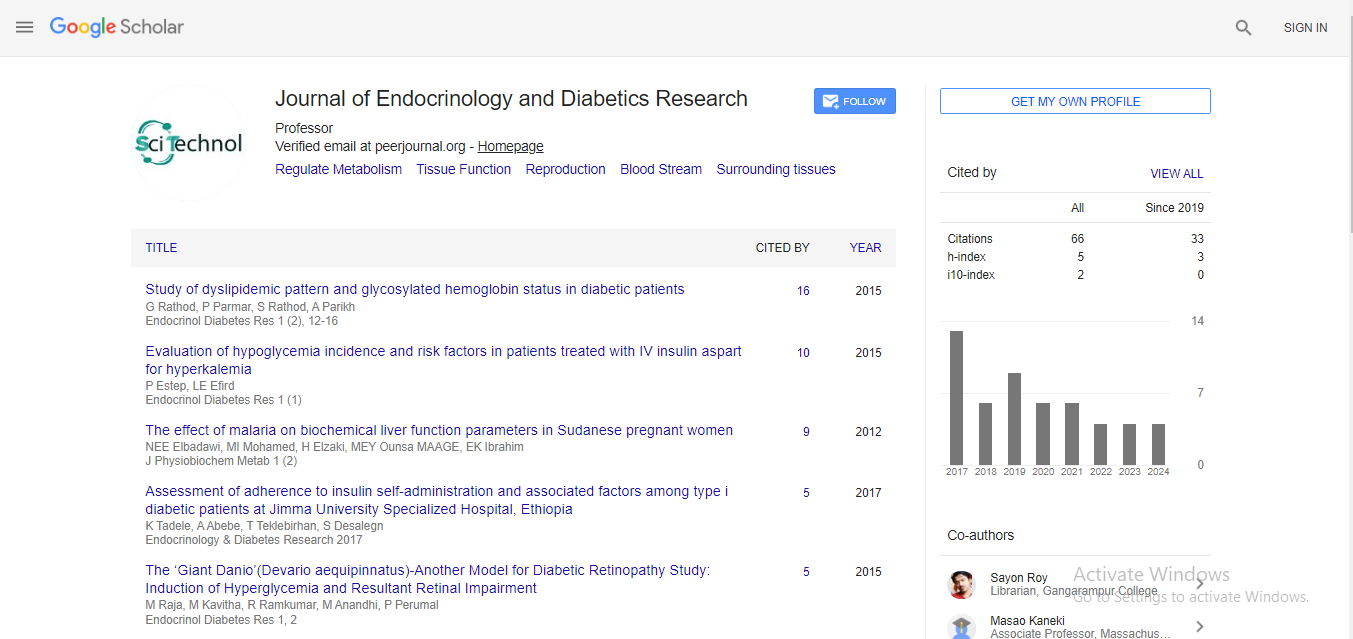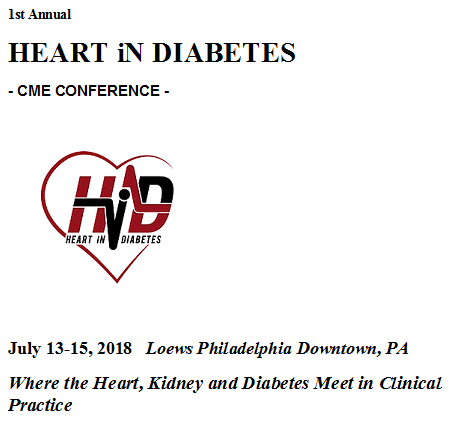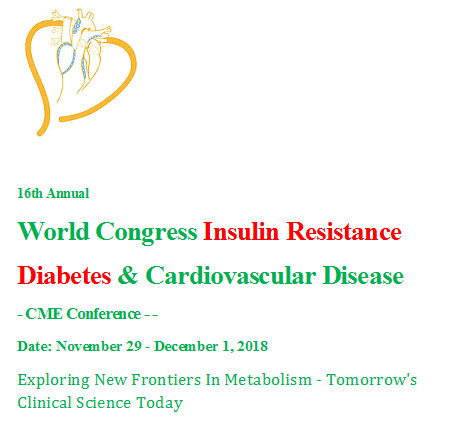Editorial, Endocrinol Diabetes Res Vol: -11 Issue: 1
Beta-Cell Regeneration: A New Frontier in Diabetes Therapy
Huang Li*
Department of Biotechnology, Shanghai Jiao Tong University, China
- *Corresponding Author:
- Huang Li
Department of Biotechnology, Shanghai Jiao Tong University, China
E-mail: li236@gmail.cn
Received: 01-Feb-2025, Manuscript No. ecdr-25-169195; Editor assigned: 4-Feb-2025, Pre-QC No. ecdr-25-169195 (PQ); Reviewed: 19-Feb-2025, QC No. ecdr-25-169195; Revised: 26-Feb-2025, Manuscript No. ecdr-25-169195 (R); Published: 30-Feb-2025, DOI: 10.4172/2324-8777.1000427
Citation: Huang L (2025) Beta-Cell Regeneration: A New Frontier in Diabetes Therapy. Endocrinol Diabetes Res 11:427
Introduction
Diabetes mellitus is one of the most pressing global health challenges of the 21st century, affecting over 537 million people worldwide. Central to both type 1 and type 2 diabetes is the loss or dysfunction of pancreatic beta cells—the specialized insulin-producing cells of the islets of Langerhans. In type 1 diabetes (T1D), autoimmune destruction leads to near-total beta-cell loss, while in type 2 diabetes (T2D), beta-cell exhaustion and apoptosis contribute significantly to disease progression. Current therapies manage symptoms but do not restore the endogenous ability to regulate glucose. Beta-cell regeneration—the ability to restore or replace functional beta-cell mass—has emerged as a promising therapeutic strategy to potentially reverse diabetes [1].
Diabetes mellitus is a chronic metabolic disorder characterized by elevated blood glucose levels, primarily due to insufficient insulin production or impaired insulin action. Central to the pathophysiology of diabetes, especially type 1 diabetes (T1D) and advanced type 2 diabetes (T2D), is the loss or dysfunction of pancreatic beta cells. These specialized cells, located in the islets of Langerhans, are responsible for producing insulin—the hormone essential for regulating blood sugar. In T1D, an autoimmune attack leads to near-total destruction of beta cells, resulting in absolute insulin deficiency. In T2D, progressive beta-cell dysfunction combined with insulin resistance contributes to hyperglycemia and disease progression [2].
Conventional diabetes treatments, such as insulin injections or oral hypoglycemic agents, focus on controlling blood glucose but do not address the underlying loss of beta cells. Consequently, there is a growing need for therapies that restore or replace functional beta-cell mass to provide a more definitive and durable cure.
Beta-cell regeneration has emerged as a promising frontier in diabetes research. It refers to the biological processes that increase beta-cell numbers and function, either by promoting the replication of existing beta cells, inducing differentiation of precursor or non-beta cells into insulin-producing cells, or through stem cell–based therapies. Understanding and harnessing these regenerative mechanisms could revolutionize diabetes treatment by restoring the body’s innate ability to produce insulin.
Current research explores multiple avenues for beta-cell regeneration, including stimulating endogenous beta-cell proliferation, reprogramming other pancreatic cells, and developing stem cell–derived beta cells for transplantation. Despite significant advances, challenges remain, such as limited regenerative capacity in adult humans and the need to protect newly formed beta cells from immune attack, particularly in T1D [3].
In summary, beta-cell regeneration holds tremendous potential to transform diabetes management from symptomatic treatment to curative therapy, making it one of the most exciting areas of endocrinology and regenerative medicine today [4].
Mechanisms of Beta-Cell Regeneration
Beta-cell regeneration can occur through several biological pathways:
Replication of Existing Beta Cells
In young individuals and rodents, beta cells can replicate in response to injury or increased metabolic demand. However, in adult humans, this capacity is significantly reduced. Researchers are investigating how to reactivate this dormant potential. Key molecules involved in cell cycle regulation—such as cyclin D, p16INK4a, and the DYRK1A pathway—are being explored to promote beta-cell proliferation [5].
Neogenesis from Pancreatic Progenitor Cells
Pancreatic progenitor cells can potentially differentiate into beta cells. During embryonic development, the transcription factor Neurogenin-3 (Ngn3) is critical for endocrine cell development. Some studies suggest that under specific conditions, adult ductal or acinar cells can express Ngn3 and differentiate into insulin-producing cells, mimicking developmental processes [6].
Transdifferentiation of Other Pancreatic Cells
Recent studies show that alpha cells (which produce glucagon) and even acinar or delta cells can be reprogrammed to adopt beta-cell-like characteristics. This phenomenon, known as transdifferentiation, has been demonstrated in mouse models through the manipulation of key transcription factors like Pdx1, MafA, and Ngn3.
Stem Cell–Derived Beta Cells
Human pluripotent stem cells (hPSCs), including induced pluripotent stem cells (iPSCs), can be differentiated into beta-like cells in vitro. These cells, when transplanted into diabetic mice, can restore glucose regulation. Companies like Vertex Pharmaceuticals are conducting clinical trials of stem cell-derived beta-cell replacement therapies, offering hope for long-term insulin independence [7].
Current Therapeutic Approaches
Pharmacological Agents
Small molecules like DYRK1A inhibitors (e.g., harmine) have shown promise in inducing beta-cell proliferation in preclinical studies. GLP-1 receptor agonists and DPP-4 inhibitors, commonly used in T2D, also exhibit modest effects on beta-cell preservation and function.
Gene and Cell Therapy
Gene therapy approaches aim to overexpress beta-cell transcription factors in other pancreatic or even liver cells to convert them into insulin-producing cells. Researchers are also exploring the use of CRISPR-Cas9 to correct genetic defects or enhance beta-cell function in vitro before transplantation [8].
Encapsulation and Immunoprotection
One of the major challenges in beta-cell replacement therapy, especially in T1D, is immune rejection. Encapsulation devices allow transplanted beta cells to function while being protected from immune attack. Technologies using hydrogel or alginate matrices are under development [9].
Immunomodulation
In T1D, even if new beta cells are generated or transplanted, they are likely to be destroyed by the immune system. Thus, immune interventions—such as T-regulatory cell therapy or checkpoint inhibitors—are being studied to preserve and protect regenerated beta cells.
Challenges and Limitations
Despite remarkable progress, several obstacles remain:
Limited replication in humans: Unlike rodent models, adult human beta cells have very low replication potential, making translation challenging.
Autoimmune relapse in T1D: Newly formed beta cells in T1D risk being destroyed again unless autoimmunity is controlled.
Tumor risk: Stimulating cell proliferation raises concerns about unregulated growth and cancer development.
Functional maturity: Many stem cell-derived beta-like cells fail to fully mimic the glucose-responsive behavior of native beta cells [10].
Ethical and regulatory hurdles: Stem cell therapies, especially those derived from embryonic sources, raise ethical considerations.
Future Directions
The future of beta-cell regeneration lies in combination therapies—targeting both the biological replacement of beta cells and the immune system. For example, combining beta-cell regeneration with antigen-specific tolerance therapies could offer a cure for T1D. Advances in single-cell genomics, tissue engineering, and machine learning are enhancing our understanding of beta-cell heterogeneity and regeneration dynamics.
Furthermore, ongoing clinical trials involving encapsulated stem cell-derived beta cells (e.g., VX-880 by Vertex) have shown early promise in restoring insulin production without hypoglycemia in T1D patients. The coming decade may witness personalized regenerative medicine where patients receive tailored therapies based on their genetic and immunological profile.
Conclusion
Beta-cell regeneration represents a transformative avenue in the quest to cure diabetes. By harnessing the body’s innate regenerative mechanisms, cellular plasticity, and advanced biotechnological tools, researchers are making significant strides toward restoring natural insulin production. While challenges remain, continued interdisciplinary research and clinical innovation bring hope that one day, diabetes may not just be managed—but reversed.
References
- Schellenberg ES, Dryden DM, Vandermeer B et al. Lifestyle interventions for patients with and at risk for type 2 diabetes: a systematic review and meta-analysis. Ann Intern Med. 159: 543-551 (2013).
- Schwingshackl L, Hoffmann G, Lampousi AM et al. Food groups and risk of type 2 diabetes mellitus: a systematic review and meta-analysis of prospective studies. Eur J Epidemiol 32: 363-375 (2017).
- Reynolds A, Mann J, Cummings J et al. Carbohydrate quality and human health: a series of systematic reviews and meta-analyses. Lancet. 393: 434-445 (2019).
- Beccuti G, Monagheddu C, Evangelista A et al. Timing of food intake: Sounding the alarm about metabolic impairments? A systematic review. Pharmacological Research. 125: 132â??141 (2017).
- Anderson JW, Ward K High-carbohydrate, high-fiber diets for insulin-treated men with diabetes mellitus. Am J Clin Nutr. 32: 2312-21 (1979).
- Booth FW, Chakravarthy MV Physical activity and dietary intervention for chronic diseases: a quick fix after all. J Appl Physiol. 100: 1439-40 (2006).
- Roberts CK, Won D, Pruthi S et al. Effect of a short-term diet and exercise intervention on oxidative stress, inflammation, MMP-9, and monocyte chemotactic activity in men with metabolic syndrome factors. J Appl Physiol. 100: 1657-65 (2006).
- Skov J, Eriksson D, Kuja-Halkola R et al. Co-aggregation and heritability of organ-specific autoimmunity: a population-based twin study. Eur J Endocrinol 182: 473-480 (2020).
- Hyttinen V, Kaprio J, Kinnunen L et al. (2003) Genetic liability of type 1 diabetes and the onset age among 22,650 young Finnish twin pairs: a nationwide follow-up study. Diabetes. 52: 1052-1055.
- Tinajero MG, Malik VS, an Update on the Epidemiology of Type 2 Diabetes: A Global Perspective. Endocrinol Metab Clin.50: 337-355 (2021).
Indexed at, Google scholar, Crossref
Indexed at, Google scholar, Crossref
 Spanish
Spanish  Chinese
Chinese  Russian
Russian  German
German  French
French  Japanese
Japanese  Portuguese
Portuguese  Hindi
Hindi 


